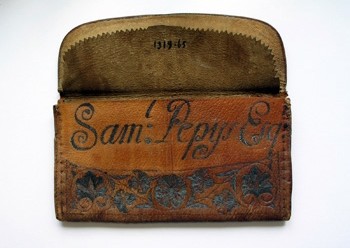POSTED ON
Samuel Pepys, his Diary and his Wallet

Just last week BBC Radio 4 was running the Diary of Samuel Pepys. He began writing it in 1660, when he was just 26. You can still hear it on the BBC Listen Again system which I think works free of charge worldwide. Sadly the Northampton based Museum of Leathercraft does not have copy of the diary but it does have his wallet. It is just one of the many items that make the Museum collection one of the very best in the world. Both Mark Wilkinson and I are Trustees as is Martin Pebody who represents the Guild of Leathersellers on the University Leather Industry Advisory Committee. Many of you will remember the famous Pebody tannery outside Northampton. You can find the Museum via its web site http://www.museumofleathercraft.org/ or its Facebook page. The Trustees have been working for some years to gather the funding to move into the old Pearce’s Tannery and in the meantime part of the collection is open to the public in the Abington Museum in Northampton.
We are just about to start the autumn season of trade shows with the industry preoccupied with the potential for a double dip in the western economies and all the issues of the current highs in raw material prices. High prices are squeezing margins too much yet a big drop will devalue inventories and create equally big problems. Interesting discussions lie ahead. I wonder what Pepys would have made of it all? The great thing about Northampton is that we have this continuum of knowledge from history through to the future. As well as the Museum of Leathercraft we have the Shoe Museum and the Leather Conservation Centre while at the other end of the time line we have Tony Covington’s recent text book and his research on the link lock mechanism which leads the leather industry into the reality of tomorrow. In Northampton we also have businesses which deal with the whole supply chain. Top shoe makers in welted footwear and leathergoods makers like Tusting – just featured in the UK September GQ – a small tanning presence still along with consultancy and education with Moulton College and the University going from grass back to grass.
Good History Searches for True Facts
Looking at some of the recent work from Greenpeace this holistic and complete approach to understanding our industry is important as there seems to have been a distinct shift from objective analysis towards emotional marketing which involves getting the publicity before anyone can challenge the facts. Recent documents from them on chemicals in clothing and its manufacture and the Argentine tanning industry are cases in point where there appears to be very good reason to wary of the Greenpeace case. No one disputed Slaughter in the Amazon and the industry reaction has been good but there is still a lot of evidence that we do not have the complete picture even here on the balance of grassland pasture, forest destruction and the danger of dealing with Brazil while ignoring forest destruction in Paraguay just because it is less emotive.
Of course digging up the true facts is what the Archaeological Leather Group is all about. It is not a Northampton organisation but with Roy Thomson (ex Strong and Fisher and ex Leather Conservation Centre) as it is Treasurer does have many local links. Their next meeting is entitled “Why Leather” on 8th September in London and look quite fascinating. Clashes with ACLE Shanghai, so here the past and present do not reside easily together. The Group have also just published a book on old tanneries that was built out of the papers at a previous all day conference. (Leather Tanneries The Archaeological Evidence) It appears that every time people find lots of bits of leather in a hole in the ground they jump to the conclusion of it being a tannery pit, whereas it is more likely to be a shoe maker, other leather user or just lots of bits of leather thrown into a hole in the ground. Very early tanneries used the rivers for their wet work so often not a lot is left. The book helps tell us what to look for and goes round the world helping us understand historic processes and what evidence we can now expect to find to evidence and ancient tannery. Like Roy Thomson and Marion Kyte’s book on conservation these books tell modern tanners a huge amount that is interesting and potentially valuable.
Michael Redwood
25th August 2011